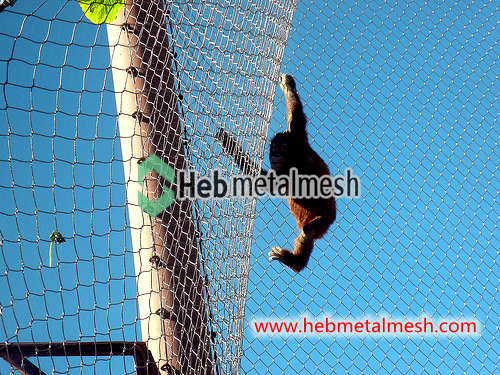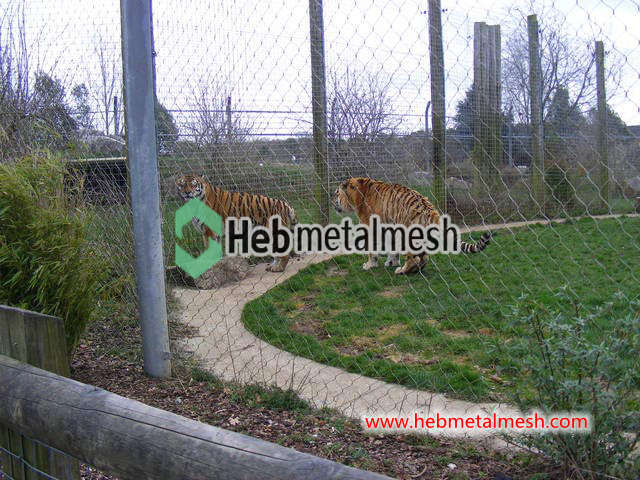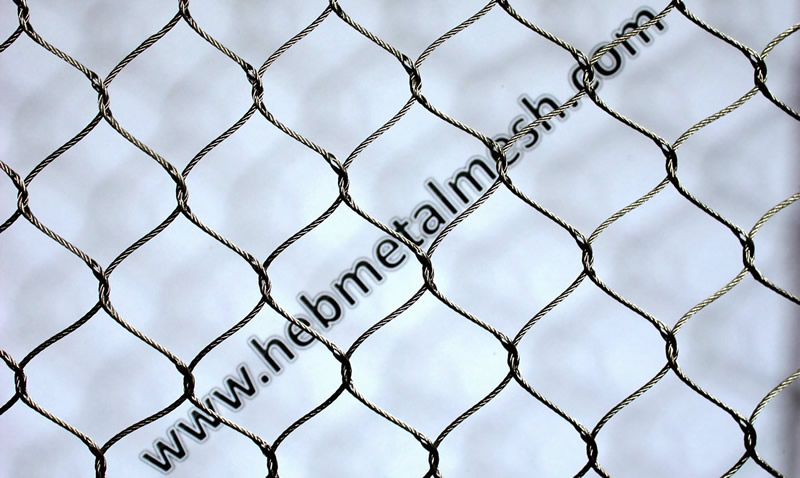Introduction to Cable Netting
Cable netting is a versatile barrier solution that consists of intertwined steel cables, creating a robust net-like structure. It is commonly utilized across various industries for its unique ability to provide strength while maintaining visibility. This feature makes it particularly valuable in applications where safety and aesthetics must coexist, such as in construction sites, wildlife management, and sports facilities.
The primary design of cable netting allows it to withstand considerable loads, making it an excellent option for stabilizing slopes or free-standing constructions that require reinforcement. The netting is typically constructed from high-tensile strength materials, ensuring durability and resilience in extreme conditions. Different configurations can be employed, including various mesh sizes and cable gauges, catering to specific requirements dictated by the operational environment and intended purpose.
One of the most appealing aspects of cable netting is its adaptability. It can be tailored to meet the needs of different sectors, be it agriculture, where it serves to protect crops from wildlife, or construction, where it provides a protective barrier against falling debris. The installation process is relatively straightforward, contributing to its efficiency as a barrier solution. Additionally, cable netting contributes to erosion control, guiding soil movement and reducing damage caused by heavy rainfall.
As a barrier option, cable netting not only promotes safety and security but also fosters a less intrusive visual barrier compared to solid walls or fences. This quality allows for natural light and air circulation, maintaining an open environment while protecting the designated area. Thus, cable netting serves as a comprehensive solution in various applications, reflective of its growing significance in contemporary infrastructure and landscape management.

Benefits of Using Cable Netting
Implementing cable netting as a protective barrier offers an impressive array of advantages that make it an ideal choice for various applications. One of the primary benefits is its remarkable durability. Crafted from high-tensile materials, cable netting is designed to withstand harsh environmental conditions, including extreme temperatures, heavy winds, and impact forces. This resilience significantly reduces the need for frequent replacements, ultimately leading to lower maintenance costs over time.
Cost-effectiveness is another important factor. When compared to traditional fencing solutions, cable netting can be installed at a fraction of the cost. Its lightweight nature allows for easier transport and quicker installation, resulting in reduced labor expenses. Moreover, the long lifespan of cable netting minimizes the overall expense of barrier solutions, making it a financially prudent option for both residential and commercial installations.
Environmentally, cable netting stands out as a sustainable choice. The materials used in its fabrication can often be recycled, and the design promotes minimal disruption to local ecosystems. This feature is particularly significant for those looking to maintain biodiversity in areas where wildlife is present; cable netting provides a barrier without completely obstructing the habitat. Additionally, its open structure allows for air and light to pass through, reducing its impact on the surrounding environment.
One of the most notable advantages of cable netting is its inherent ability to maintain visibility while ensuring safety. Unlike solid fences, cable netting offers unobstructed views, which can be essential in various settings—whether in urban environments where sightlines are crucial for safety or in rural areas where preserving scenic views is necessary. By integrating safety and visibility, cable netting presents a versatile barrier solution suitable for a variety of contexts.

Common Applications of Cable Netting
Cable netting serves a wide array of applications across various environments, thanks to its versatility and effectiveness as a barrier solution. One of the most prevalent settings for employing cable netting is construction sites. In these areas, the netting acts as a safety measure by preventing debris from falling and creating hazards for workers and pedestrians. By enclosing an entire site, contractors ensure compliance with safety regulations while maintaining a clear demarcation of the work zone.
Another significant application of cable netting is in sports facilities. Particularly in the case of fields and stadiums, it can be used to enclose perimeters, ensuring that balls do not stray into spectator areas or adjacent properties. This not only enhances the safety of spectators but also preserves the integrity of the sporting event itself by preventing interruptions caused by loose balls.
Wildlife protection areas also benefit from cable netting, as it provides a crucial barrier to protect both natural habitats and the animals within them from human encroachment. For example, cable netting can be deployed around sensitive ecological zones to deter unauthorized entry while allowing for natural ventilation and visibility. This protective measure contributes to conservation efforts by minimizing human impact on vulnerable species and their environment.
In urban infrastructure, cable netting is increasingly used for securing areas such as bridges and tunnels, where falling debris poses a risk to vehicles and pedestrians below. In these settings, the installation of cable netting not only enhances safety but also allows for maintenance activities without the need for extensive scaffolding, thereby providing a cost-effective solution.
Overall, cable netting proves to be a multi-functional barrier solution that addresses the specific needs of construction, sports, wildlife protection, and urban settings while promoting safety and efficiency.
Installation Process of Cable Netting
Installing cable netting involves a systematic approach that ensures both effectiveness and durability. To begin, it is essential to gather all necessary tools and materials, which typically include cable netting rolls, posts, anchors, tensioning devices, a measuring tape, level, wire cutters, and safety gear such as gloves and goggles.
Once you have everything on hand, the first step is to determine the area to be fenced with cable netting. Clear the area of debris and measure the dimensions accurately to ensure the right amount of netting is purchased. After marking the installation points for the posts, dig holes at each corner and every ten feet or so along the line. The depth of these holes should be at least one-third the height of the posts to guarantee stability.
Next, place the posts in the holes and fill them with concrete for added strength. Ensure that each post is vertically aligned using a level. It is crucial to give the concrete enough time to cure, typically 24 to 48 hours, before proceeding with the next steps. Following the curing period, the cable netting can be unrolled and positioned against the posts.
Using the tensioning devices, attach the cable netting securely to the posts. The tensioning devices help maintain a taut installation, preventing sagging over time. It’s important to regularly check the tension and make adjustments as necessary to maintain an effective barrier. As you work, adhere to safety measures, ensuring that no loose cables pose a risk of injury.
Finally, inspect your installation thoroughly for any gaps or weaknesses. If everything is securely in place, you will have created a robust cable netting barrier that meets your requirements. Proper preparation and execution of these steps will ensure a successful installation with long-lasting performance.
Maintenance of Cable Netting Structures
Maintaining cable netting structures is essential for ensuring their long-term effectiveness and integrity as a barrier solution. Regular inspection and maintenance are fundamental practices that help in identifying potential weaknesses or damage before they result in significant issues. It is generally recommended that cable netting systems undergo thorough inspections at least bi-annually. However, factors like location, weather conditions, and usage frequency may necessitate more frequent evaluations.
During these inspections, particular attention should be paid to the condition of the cables, knots, and any supporting structures. Signs of wear, corrosion, or fraying should be documented, and any immediately concerning issues should be addressed. Cleaning is another critical aspect of maintaining cable netting. Accumulation of debris, vegetation, or dirt can compromise the barrier’s effectiveness and aesthetic appeal. Cleaning procedures typically involve gently removing buildup manually or using water sprays to avoid physical damage to the netting materials.
Should any areas of cable netting be found to have sustained damage, prompt repairs are necessary. Depending on the severity of the damage, this may involve replacing individual cables, retying knots, or reinforcing anchor points. In some cases, a professional service specializing in barrier maintenance may be required to ensure proper repair techniques are implemented, promoting the long-lasting stability of the structure.
The importance of regular upkeep cannot be overstated. Neglecting maintenance can lead to a decline in performance, potentially rendering the cable netting ineffective and raising safety concerns. Therefore, developing a structured maintenance schedule is vital to uphold the safety standards and functionality of cable netting systems, ensuring they continue to serve as reliable barriers for years to come.
Comparing Cable Netting to Other Barrier Solutions
When evaluating barrier solutions, it is essential to compare cable netting with prevalent alternatives such as chain-link fencing, solid walls, and various mesh systems. Each option presents unique attributes that can significantly influence the best choice for specific applications, considering factors like cost, effectiveness, maintenance requirements, and aesthetics.
Cable netting is often favored for its superior flexibility and customization features, allowing it to fit various shapes and sizes. In terms of cost, cable netting generally incurs lower installation costs than solid walls, which can be more expensive due to the materials and labor involved in their construction. Although chain-link fencing is typically less expensive than both options, it lacks the versatility and aesthetic appeal offered by cable netting.
Effectiveness plays a crucial role in barrier solutions. Cable netting serves an important function in controlling wildlife, securing perimeters, and providing visual barriers without obstructing airflow. While solid walls provide a complete visual and physical blockade, they may not be necessary in environments where visibility is valued, such as parks or communal areas. Chain-link fencing offers good security but may not deter specific wildlife effectively, making cable netting a more viable solution where both wildlife management and security are critical.
Maintaining barrier solutions is another vital consideration. Cable netting requires minimal upkeep compared to solid walls, which may demand repairs due to weathering and damage over time. Conversely, chain-link fencing can suffer from rust and deterioration unless adequately treated. Aesthetic appeal is also a factor; cable netting has a more modern and less imposing appearance than solid barriers, which can enhance the visual landscape and blend with natural surroundings more effectively.
Case Studies of Successful Cable Netting Implementations
Real-world applications of cable netting offer compelling narratives of challenges overcome and positive outcomes achieved across various sectors. One notable case study comes from a major urban park located in an increasingly populous city. Authorities faced persistent issues with wildlife entering park premises, leading to safety concerns among visitors. By integrating cable netting around the park’s perimeter, wildlife intrusion was effectively minimized. The installation not only retained the park’s natural aesthetics but also ensured the safety of its users, demonstrating cable netting’s effectiveness as a barrier solution.
Another example can be seen in the construction industry, where a large-scale infrastructure project faced risks from falling debris. The contractors opted for cable netting as a safety mechanism during construction. By utilizing high-tensile strength cables tightened across a framework of support poles, the site ensured worker safety and compliance with regulatory standards. The deployment of cable netting not only provided immediate protection against potential hazards but also contributed to a culture of safety on site, which significantly reduced incident rates throughout the project duration.
Furthermore, an agricultural operation implemented cable netting to protect crops from bird damage. Farmers struggled with protecting their produce from avian pests, which resulted in considerable crop loss. The solution involved erecting a lightweight cable netting system above the crops. This allowed sunlight and rain to penetrate while deterring birds. The outcome was remarkable; the crop yield increased significantly, showcasing cable netting’s versatility in agricultural applications.
These case studies illustrate the adaptability and efficiency of cable netting across diverse environments. They highlight how cable netting has successfully addressed specific challenges, reaffirming its status as an essential barrier solution for various industries. Each instance reinforces the theme that with thoughtful implementation, cable netting can yield significant benefits while enhancing safety and security.
Regulatory Considerations for Cable Netting
The installation of cable netting as a barrier solution entails several legal and regulatory considerations that must be meticulously addressed to ensure compliance and safety. Prior to the installation process, it is crucial to evaluate local zoning laws, which dictate the specific requirements and restrictions applicable to the use of barrier solutions such as cable netting in certain zones. These regulations may cover aspects like height limitations, material specifications, and distance from property lines, making it imperative for property owners to engage with local authorities and obtain the necessary permits.
Furthermore, safety regulations play a significant role in the design and installation of cable netting. Depending on its application—be it for construction sites, agricultural boundaries, or wildlife protection—there may be specific standards established by governmental bodies or industry organizations that must be adhered to. These standards ensure that the cable netting installed is durable, reliable, and able to perform its intended function without posing risks to individuals or the environment. For example, in construction settings, compliance with Occupational Safety and Health Administration (OSHA) regulations may be necessary to protect workers from site hazards.
Additionally, it is important to consider the guidelines set forth by relevant environmental agencies, especially in scenarios where cable netting interacts with wildlife habitats. Some regions may require environmental assessments or permits that evaluate potential impacts on local fauna and flora. Engaging with environmental experts can provide insight into best practices and compliance with regulations aimed at protecting ecosystems. Overall, understanding and adhering to these regulatory frameworks is essential for the successful and responsible installation of cable netting, allowing property owners to utilize this barrier solution while minimizing legal risks and enhancing safety.
Future Trends in Cable Netting Technology
The field of cable netting is on the cusp of significant advancement, influenced by both innovation and evolving requirements across various sectors. One of the notable trends is the development of advanced materials that offer enhanced durability and strength. Manufacturers are exploring high-performance synthetic fibers that not only withstand extreme environmental conditions but also minimize maintenance needs. These materials can potentially lead to longer-lasting barriers, reducing the frequency of replacements and repairs.
Moreover, there is a growing interest in the integration of smart technologies into cable netting solutions. This includes the incorporation of sensors and monitoring systems that track the structural integrity of the netting in real-time. Such innovations could revolutionize safety protocols in industries where cable netting is a primary barrier, such as construction and wildlife management. By utilizing data analytics, stakeholders can make informed decisions regarding maintenance, addressing wear and tear before significant issues arise.
Design advancements will also reshape the aesthetics and functionality of cable netting applications. We can expect to see a wider array of customizable designs that cater to specific environmental contexts, enhancing both visual appeal and efficiency. For instance, the resilience of cable netting can be complemented with integrated vegetation or camouflage elements, blending seamlessly with natural surroundings. This is particularly applicable in wildlife conservation projects where minimizing human impact is critical.
Additionally, the use of cable netting is likely to expand beyond traditional applications into innovative scenarios such as urban design and disaster mitigation. As urban landscapes continue to evolve, cordoning off spaces with aesthetically pleasing and functional cable netting could become more commonplace. These advancements illustrate a bright future for cable netting, emphasizing its role as a versatile barrier solution capable of meeting the challenges of modern environments.


